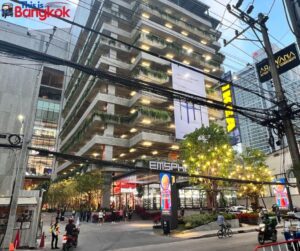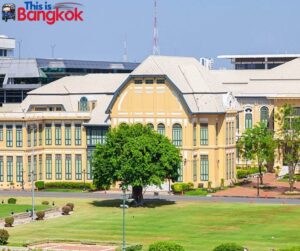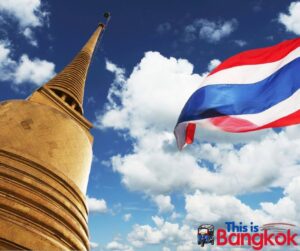Strap in, intrepid traveler, because navigating through the bustling city of Bangkok is no less than an adventurous rollercoaster ride.
With its vibrant mix of traditional tuk-tuks, speedy BTS Skytrains, and the ever-thrilling boat rides along the Chao Phraya River, Bangkok offers more flavors in transport than a street food stall in Chinatown!
So, chuck that boring city map because we’re about to embark on a wild ride through Thailand’s city of angels, where getting lost is half the fun!

Getting around Bangkok, the capital city of Thailand can be an exciting experience due to its diverse transportation options.
| Mode of Transportation | Advantages | Disadvantages | Approximate Prices | Notes |
|---|---|---|---|---|
| BTS Skytrain | Fast, efficient, avoids traffic | Limited coverage in some areas | 16-59 THB per trip | Suitable for central and some suburban areas |
| MRT Subway | Quick, integrated with other systems | Limited coverage, not as extensive as BTS | 16-42 THB per trip | Convenient for specific routes |
| Taxis | Door-to-door, air-conditioned, convenient | Traffic congestion, potential overcharging | Starting at 35 THB | Use a meter or agree on a fare beforehand |
| Tuk-Tuks | A unique experience, short trips | Negotiating fares not the most comfortable | Varies, negotiate | Short rides, negotiate the fare |
| Motorbike Taxis | Navigates traffic, convenient for short trips | Safety concerns, helmet availability | 20-60 THB per trip | Short distances, negotiate the fare |
| Public Buses | An affordable, extensive network | Limited English signage, traffic delays | 8-25 THB per trip | Suitable for budget-conscious travelers |
| Chao Phraya Express Boats | The scenic route along the river | Limited routes, no air-conditioning | 15-40 THB per trip | Great for river views and some attractions |
| Guided Tours | Professional guidance, local insights | Fixed schedules, less flexibility | Varies | Explore specific attractions with a guide |
| Cycling | Eco-friendly, access to narrow areas | Traffic hazards, limited bike lanes | Rental: 50-150 THB | Suitable for short distances, leisurely pace |
| Car Rentals | Flexibility, convenience | Traffic, parking challenges | Varies | Ideal for exploring the outskirts or for day trips |
Here are some ways to navigate the city:
BTS Skytrain (Bangkok Mass Transit System):
The Skytrain is an elevated rapid transit system connecting many significant city areas.
It’s clean, efficient, and famous for locals and tourists.
The BTS system consists of two main lines: the Sukhumvit Line and the Silom Line.
The Sukhumvit Line runs north to south, connecting the northern and eastern parts of the city to the central business district and beyond.
The Silom Line runs west to south, connecting the city center to the Silom financial district and other vital areas.
These two lines meet as Siam Square.
MRT (Mass Rapid Transit):
The MRT is a subway/metro system that complements the BTS and covers other parts of the city. It’s another convenient option for getting around.
The MRT system consists of two main lines:
The Blue Line (also known as the Chaloem Ratchamongkhon Line) and the Purple Line (also known as the Chalong Ratchadham Line).
The Blue Line is the primary line, running from Hua Lamphong in the south to Bang Sue in the north, with extensions planned.
The Purple Line connects Tao Poon in the north to Khlong Bang Phai in the west.
Taxis:
Taxis are abundant and relatively affordable in Bangkok.
Always ensure the driver uses the meter or negotiates the fare before starting your ride.
Avoid unmarked or unlicensed taxis.
The Taxi fares in Bangkok typically start at a base rate of 35 Thai Baht (THB).
After that, the fare increases based on the distance traveled and time spent in traffic.
On average, a short to medium-length taxi ride within the city might cost you around 100 to 200 THB.
However, the fare can go higher during heavy traffic or if you’re traveling longer distances.
Grab
Grab is a well-known ride-hailing and food delivery app operating in several Southeast Asian countries, including Thailand and Bangkok. Grab offers a convenient and reliable way to book rides and order food delivery through a mobile app.
So ensure to download the app before your trip!
Tuk-tuks:
These iconic three-wheeled vehicles are a fun way to travel short distances.
Negotiate the fare before you start the ride, as tuk-tuk drivers often quote high prices to tourists.
Motorbike Taxis:
Motorbike taxis can quickly maneuver through the city for shorter distances and heavy traffic.
They’re recognizable by their orange vests.
You can also negotiate the fare, but it’s usually starting at 20 Thai Baht.
Public Buses:
Bangkok has an extensive public bus network (BMTA), but it can confuse tourists due to limited English signage.
Google Maps can help you find bus routes and stops.
Boats and Ferries:
The Chao Phraya River runs through Bangkok, and there are various boat services, including express boats, river taxis, and canal boats, such as Chao Phraya and Khlong Saen Saeb express boat services.
They’re an exciting way to see the city and avoid traffic.
Airport Rail Link:
If you arrive at or depart from Suvarnabhumi Airport, the Airport Rail Link provides a fast and convenient connection to the city center.
Ride-Sharing Apps:
Services like Grab (similar to Uber) operate in Bangkok. They provide an alternative to taxis and tuk-tuks with upfront pricing.
Renting Bicycles or Motorcycles:
If you’re comfortable with the traffic and road conditions, renting a bicycle or motorcycle can be an adventurous way to explore the city at your own pace.
Walking:
Depending on your location and the distance, walking can be a great way to experience Bangkok’s street life, especially in areas like Sukhumvit, Silom, and Chinatown.
I always like to walk while traveling because you can always discover hidden gems on the way – but in Bangkok, transportation is so cheap and easy to manage that it is one of the travelers’ most minor favorite choices.
Cycling:
Cycling is a great way to explore the city and get some exercise.
It’s a fantastic way to get around the city quickly and enjoy the sights!
To start, you can join a bicycle tour of the city or rent a bike from one of the bike-sharing companies operating in Bangkok.
You can join the locals on their daily rides or sign up for a fun bicycle scavenger hunt to explore the city’s hidden corners!
Car Rental:
A car rental can be convenient if you’re comfortable driving in Bangkok’s chaotic traffic.
Just make sure always to obey the rules of the road and stay aware of your surroundings.
And let’s not forget that driving here in Thailand is on the left side, so… taxis are better.
Guided Tours:
Another excellent option for getting around Bangkok is by joining a guided tour.
You can find various tours that explore Bangkok’s temples, markets, and hidden gems tailored to your interests.
Plus, it eliminates the hassle of figuring out how to get around!
FAQ
Here are some frequently asked questions about getting around Bangkok:
How do I get from the airport to my hotel?
The easiest way is to take the Airport Rail Link’s City Line, which connects Suvarnabhumi Airport with the city center.
You can also take a taxi or limousine service directly from the airport.
What is the safest way to get around Bangkok?
Public transportation, such as the BTS Skytrain and MRT, is the safest way to get around Bangkok.
They are clean, efficient, and secure.
You can also take a taxi if you prefer a more private ride. Make sure to only use licensed taxis or ride-sharing apps like Grab.
What is the cheapest way to travel in Bangkok?
The cheapest way to travel in Bangkok is by public transportation.
The BTS and MRT are affordable, especially if you buy a day or monthly pass.
You can also take a tuk-tuk or motorbike taxi for short distances, but negotiate the fare before you start your ride.
Is a tuk-tuk cheaper than a taxi?
Tuk-tuks are usually more expensive than taxis because they are more “touristic.”
Negotiate the fare before you start your ride, as tuk-tuk drivers often quote high prices to tourists.
Is Uber available in Bangkok?
No, Uber is not available in Bangkok. You can use ride-sharing apps like Grab, which functions similarly to Uber.
You can also take a taxi or limousine service directly from the airport or ask the hotel staff for help finding a taxi.
What is the best way to get around Bangkok during rush hour?
During rush hour, public transportation such as the Skytrain and MRT is the best way to get around Bangkok quickly and avoid traffic.
You can also take a motorbike taxi as they can maneuver through tight spots and heavy traffic.
Tips on getting around in Bangkok
- Buy a day or monthly pass for public transportation; it’s cheaper than paying per ride.
- When using taxis, tuk-tuks, or motorbike taxis, agree on the fare or ensure the meter is used before starting the journey. This helps prevent misunderstandings.
- If you’re taking a taxi, only use licensed or ride-sharing apps like Grab.
- With Bangkok’s extensive public bus network, Google Maps can help you find bus routes and stops.
- Please use the Chao Phraya River and its boat services for an exciting way to see the city.
- Enjoy a tuk-tuk ride for the experience, but be prepared to negotiate fares and avoid rides that seem overly cheap, as they may involve stops at tourist shops.
- Cycling is a great way to get around the city quickly and enjoy the sights!
- Join a guided tour of Bangkok to explore its temples, markets, and hidden gems.
- Be aware of your surroundings and obey traffic rules when driving in the city.
- Carry small denominations of Thai Baht for paying fares, as many taxis and other services may not have changed for larger bills.
- Take advantage of the efficient and well-connected public transportation systems, including the BTS Skytrain, MRT subway, and public buses. They’re often faster and more convenient than navigating through traffic.
- Bangkok’s traffic can be intense, especially during rush hours. Plan your travel times accordingly to avoid being stuck in heavy congestion.
- Before getting on a taxi or train, dress modestly with covered shoulders and knees when visiting temples or religious sites. Some places may provide sarongs or shawls for visitors to cover up.
- Be cautious of traffic, especially when crossing streets. Use designated pedestrian crossings and bridges. Also, be aware of your belongings to avoid pickpocketing.
- Bangkok’s weather can be hot and humid. Stay hydrated, wear sunscreen, and consider carrying an umbrella for shade.
- Learn a few basic Thai phrases or carry a translation app to help with communication, especially in areas with limited English.
- Research and plan your itinerary to maximize your time and avoid unnecessary backtracking.
The Bottom Line
As you can see, getting around Bangkok is easy with its various transportation options.
No matter what mode of transport you choose, Bangkok is a dynamic city with something to offer at every corner.
Remember that traffic in Bangkok can be notoriously congested, especially during rush hours.
Plan your trips accordingly and consider using public transportation to avoid traffic jams.
A navigation app like Google Maps can help you find the best routes and transportation options based on real-time traffic conditions.
Happy travels! 🛴 🚆 🚊 🚢 🚁 ❤️️












